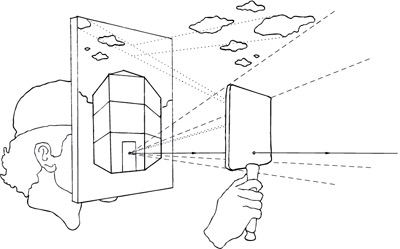
The tavoletta and the new vision devices
The exhibit Arnaldo Pappalardo conceived for the Museu da Casa Brasileira (Museum of the Brazilian House) makes use of the architectural aspects of the edifications—such as the symmetry of façades and rooms, the proportion of surroundings and gardens, which refer to Palladian villas—so as to revisit that time amid Italian Renaissance when the principles which would set the modern way of seeing and organizing space were established: the perspective. This is done to restore the technical devices which allowed observers to precisely establish the positioning of objects within the landscape, from his or her point of view: the camera obscura and most of all, the tavoletta. This enables the artist to set out an extensive critical and experimental reclaiming of the multiple apparatuses and sources used for contemporary image production.
In the beginning of the 15th century, Brunelleschi painted a small panel, a view of the Baptistry of San Giovanni in Florence, in the way an observer would see it by placing oneself on a given spot at the entrance of the Basilica of Santa Maria del Fiore. As its side measures about 15 in, the tavoletta is made to be wielded with one arm outstretched. The spectator would contemplate its reflection upon a mirror placed before the painted surface and parallel to it, by means of an orifice drilled midway upon the board. The two planes are positioned such that the image from the drawing at the mirror is extended by the images of the urban landscape.
The device of the tavoletta orifice commanded spectators to observe the painting as reflected upon the mirror from the same point of view at which the painter had placed himself. That is, the small hole corresponds to a given height proportional to the one at which the painter had positioned himself/herself in order to make the drawing. The straight line which connects the painter’s eye to the center of the portrayed scene is the axis of a visual pyramid whose vertex is coincident with the vanishing point.
Perspective organizes space in cube-like fashion as limited by the ocular pyramid, a network of lines drawn from the point of view—the Euclidian vision of space. Within such a cube, all of the elements are measurable over the same scale, places and objects meet at the point of concurrence of the geometric coordinates, vertical and longitudinal, whatever be the real distance of things. Perspective allows for a stabilization of size relationships as captured by the eye, reducing faraway dimensions to the same scale.

Perspective viewing highlights symmetry and the proportion of elements. It allows for establishing the decrease or enlargement of things with exactitude, which for the human eye arises either from their distance or approximation. Constructions, plains and mountains display their sizes corresponding to the distances where they find themselves in. Perspective provides the rule for the reduction of objects—a scale—with respect to the distance they are seen. Our look obeys the metric rule of perspective. The observer is free to contemplate the landscape, but when one looks at a spot, the baptistry for example, the surroundings will grow organized for this look according to a given a priori scheme, after a precisely framed perspective.
It is essential that the point of view chosen by the painter can be deduced from the very painting created from the tavoletta. This implies that the painting allows one to place the point of view (the observer) location in real space with relative precision. The problem regarding the distance between the point of view and the object is the heart of the matter. The element located far away would serve as a reference for determining the rate at which things are reduced according to the distance. Where was the vanishing point of the perspective-painted panel located? The position which it assigns to the painter at the entrance of the basilica implies that such spot must be marked at the tavoletta`s geometric center.
Any painting set up in perspective requires to be seen from a given spot, established by a rectangular cartesian coordinate system. What`s surprising regarding the device conceived by Brunelleschi is that the spot where the observer should be placed, such unique spot from where the painting requires to be seen in order to produce the perspective effect, finds its correspondence in the picture. The point of view coincides with the vanishing point arising from projection lines. Brunelleschi`s technical invention consists in opening up an orifice at the panel center, at the vanishing point, so as to demonstrate that such a spot corresponds to the point of view.
Therefore, perspective is also the imposition of an order to landscapes, from a privileged look. There are two constants in perspective: the center (the dominating point of view) and the reticulation of space (Euclidian homogenization). The tavoletta, a frame that is positioned in place of an existing construction (or of one not yet constructed) is an in-advance illusion that contributes to the effective setting up of the urban design it portrays. The observer sees the entire scene getting ordered according to his or her vision. Construction layouts, positioned according to their floor plan orthogonal patterns, make vision and drawing devices` strengths plainly noticeable.
There is an element though which resists being framed within such geometric space device: the clouds in the sky. On the tavoletta, in the place corresponding to the sky, there is a polished silver surface which reflected the real sky, loaded with wind-driven clouds. The sky is not painted, but gets reflected on the polished surface. The observer therefore sees the sky as the reflection of a reflection.
Perspective only recognizes things which take up a place and whose contours can be defined by lines. The sky does not take up a place, it`s irreducible to any measurements, and does not let itself be known by comparisons. The sky can neither be represented nor can one draw cloud contours or analyze their forms in terms of surfaces.
Clouds, such as shadows and rocky reliefs, belong to the universe of that which can’t be painted. That which does not let itself be framed by conic lines and projection planes, which disturbs the orthogonal and closed tectonic space of perspective.
The technical and theoretical problems posed by depicting a heavenly element and an aerial movement on a two-dimensional canvas are fundamental for building up a space representation system in perspective. Wouldn’t the depiction of aerial elements such as clouds, these “surfaceless bodies”, remain beyond perspective’s possibilities, which operates by ruling out of its field whatever escapes from its jurisdiction? How to represent, trace by trace, what does not possess contours?
Brunelleschi`s perspective machine is designed to place objects correctly in space, each thing being defined by having its own place. This is the reason why the sky is not represented but shown directly: the sky does not have a place. It can’t be measured or compared and therefore cannot be represented by the system of proportions which defines the space ordered by perspective viewing.
The originality of the Tavoletta`s lies in building up perspective, at the same time in giving room to this non-controlled background, irreducible to its geometric rules, one which could just be shown through a mirror. The “cloud mirror” shows everything which seems to escape from formatting and scale positioning, according to distance measurements. Brunelleschi`s sky is a meteorological one where clouds slide driven by the wind, escaping from geometry`s measurements. The clouds in motion draw a vanishing line.
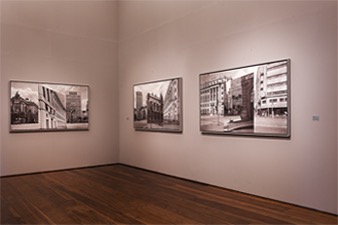
The device created by Pappalardo is made up of different technical and imagery assignments. Besides the relationship towards the architecture of the place, the artist makes use of several equipment (several movie-, video- and photography cameras), visualization apparatuses and support materials (screens, backlights, lightboxes and glass sheets), in order to produce from plain photographic images up to complex installation artworks, endowed with several elements.
The exhibit takes up three rooms and the yard of this Neo-Palladian house. In the main room, a series of photographs make direct reference to the tavoletta principle. These are photos made from 8 × 10 plates, depicting a crossroads at downtown, where a large mirror (3` 3” × 4` 11”) was placed so that each image displays mirrored portions reflecting a stretch of the city which lies behind the camera. It establishes a composite urban landscape, in which one does not know what the mirrored portion is. Re-elaborated and mingled voluminousness, classical and modernistic constructions.
That`s a first-surface mirror whose silvered face is on the outermost side, a mirror capable of the greatest definition possible, which allows focusing in infinity. This mirror`s edges, however, get slightly out of focus, so that the physical device set up in place can be seen and people can realize this is not just a mere juxtaposition of images.
The vanishing point resulting from the convergence of the parallel lines existing in the landscape is located within the composition so that the camera is aligned by it. The photos are made without any digital perspective adjustment. In the exhibit, images are laid out so that the vanishing points correspond to the observer`s point of view.
The sequence of images in perspective makes up a 360-degree eye movement, a panoramic view. That is, all takes have been made practically from the same spot at small displacements, for obtaining better views. But it`s a panoramic shot made up of various unconnected segments. Each perspective shot contains a cutout in its central portion, corresponding to the mirrored image of what`s behind it. The result then is a landscape in which distant areas appear nearby and close areas appear faraway.
The mirror blurs conventional perspective, taking the vanishing point elsewhere. On the tavoletta, the mirror is located upfront, and the reflected image matches the perspective. What lies behind is equal to what`s ahead. It`s different here however. The mirror is placed slightly angled in relation to the image frontal plane, so that what is reflected does not exactly match the remainder of the landscape. Constructions` rectangular façades, possessing orthogonal lines, soon evince the torsion effect produced. By turning a mirror, a vanishing point shift takes place.
Perspectives reproduce the tavoletta device by inserting new stretches of the landscape. Here, however, the optical illusionism of Renaissance design is broken due to image fragmentation, the evident discontinuousness in the pictured landscape. As Pappalardo reconsiders Brunelleschi`s apparatus by paying a true homage to the first modern device for viewing the city, he also deconstructs the tavoletta, revealing how its representation mechanism works.
Sideways to this, in the same room, we find another installation artwork: intensely colored photos of a theatrical staging, created with a panoramic camera and seen from backstage. The sight must squeeze through the slots available among the bodies and objects which cram the scene. Such as in the renowned picture by Velázquez, where space is organized by perspectives drawn by the looks from different characters, all of the characters are seen turned toward one spot. But it`s not possible here, due to obstructions, to see what they are looking at. While mirror-created perspectives generally take their views, though problematized ones, towards infinity, in this image the vanishing point—the perspective constituent principle—is hidden.
The installation artwork is made up of an overhanging, tilted screen, which floats in the air. On it, an old Super-8 black and white film taken from an airplane window is projected alternately. We see the clouded sky framed by the airplane wing. On the other film, this one in color and high definition, a ram introduced into what seems to be a fluid lets off a red substance which increasingly takes hold of the entire screen, like a nebula or clouds. Clouds once more. That which does not let itself be framed.
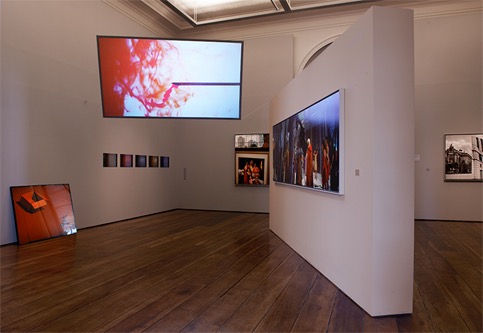
We find two more photos yet, depicting details from a Renaissance painting, displaying a colonnade and a baroque tapestry. Opaque surfaces lacking depth, images of intense materiality. Another spatial arrangement is configured in this second half of the room, based upon landscape density and upon obstructing looks. Space to plane reductions, which only clouds manage to escape from.
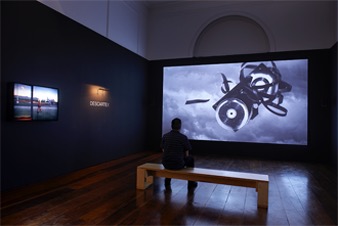
Two more rooms, located symmetrically to the entrance on both sides, make up the exhibition. The room to the right is dominated by a large screen on which a sequence in HD is projected. Against a clouds backdrop, different objects float in surrealistic manner, wastes found in the streets. There is no sense of scale, no positioning of objects in space. There is no possibility of building up perspectives here. Things are submerged in an unmeasured world, in which such organization is not possible: the clouded sky.
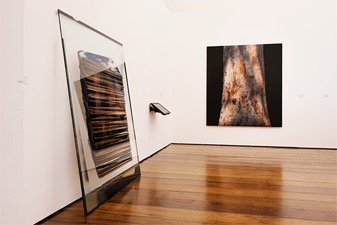
In the other room to the left, devices presenting completely distinctive technical solutions. A large photograph, a slide shot enlarged directly over a glass sheet, shows a landscape with clouded sky. On a projection, a sequence of old photos being adjusted over a lightbox, another vision apparatus. On a backlight on the floor, a photomontage shows a view of an aquarium containing fish. Two more photographs show people watching the sea, birds crossing over heavy clouds. All is made up of glazed and crosscut surfaces, reflections and mirror images.
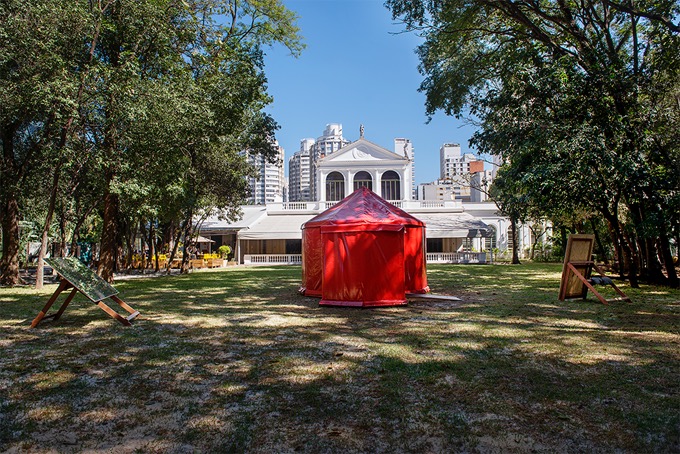
Last, in the yard, disrupting the construction’s supporting axis and symmetry of space, Pappalardo set up a camera obscura, built within a large 8ft-high tent measuring 13ft in diameter, similar to those seen in Italian cities in the period on holiday occasions. A circular construction, a 12-sided polygon, allowing different views.
The device, based upon an orifice through which one captures landscape images, constitutes the proto-photographic principle of the camera obscura. It`s a box or a closed compartment possessing a small hole (pinhole) which allows light passing through it to be projected on the back wall. It was used to build perspectives, allowing one to see orthogonality in depth, the location of bodies in space.
Contrary to the tavoletta, a much more complex apparatus, an optical-geometrical device which arranges elements from external space, the camera obscura is an opening that allows the admission of light, forming an image upon a darkened barrier. It brings a cutout of the world to an internal space, to where observation takes place, wavering in fleeting images.

In the camera obscura images are formed just by a hole drilled on the walls, without making use of lenses. Projected images are therefore diffuse and inverted. For this device`s reconstruction, Pappalardo set up diffuser panels whose sides measure 31.5 in, on which images can be more clearly seen.
There are three apertures on the sides and three more on the top. By means of the apertures above, a light projects the sky and clouds. The clouds, as always. To the sides, mirrors placed outside also reflect the sky. Placed at different distances from the apertures, they create distinct cutouts from the landscape. For those who observe the projections from the inside of the camera obscura, different scale and composition relationships are obtained. The device of the camera obscura is also reinvented by Pappalardo.
By means of the camera obscura, the tavoletta, the palatial construction; photographs, video and film; screens, glass sheets and mirrors, Pappalardo focuses on a constituent element of the contemporary condition: the visual perception, the image.


